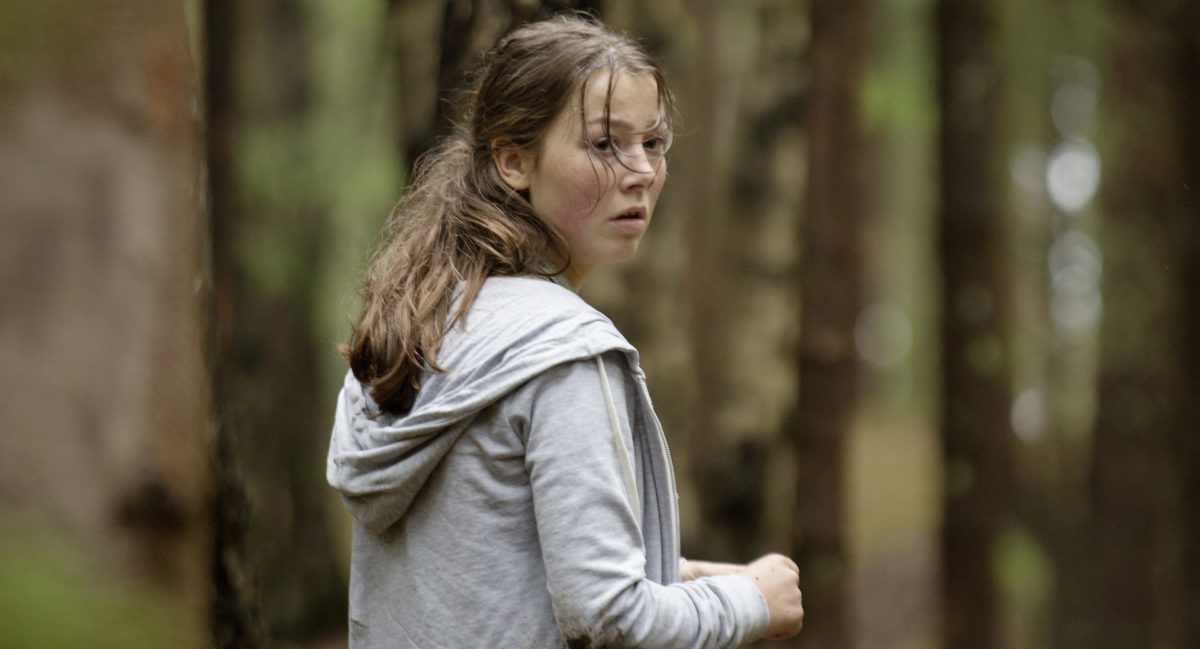Erik Poppe’s assaulting Utøya 22. Juli begins with an attack on the audience: the viewer is confronted with security camera footage of the terrorist attacks in Oslo that took place on July 22, 2011. People are blown to shreds; a dark prelude to a horrible movie that reconstructs the horrendous massacre caused by alt-righter Anders Breivik, who ruthlessly butchered innocent children for 72 minutes straight.
Cut to a peaceful image of the island Utøya, where a few hundred teenagers enjoy their Labour Party summer camp. From here on, Utøya is shot in one impressive continuous take, where the camera stays close to Kaja (Andrea Berntzen), one of the (fictionalized) adolescents who temporarily retreated to a lifestyle of socialist-democratic ideals, barbecuing, swimming and colourful discount store tents. The children hear about the Oslo attack and, affected by it, discuss terrorism and the state of the country over some waffles. At the end of the dispute, Kaja gets offered a ‘peace waffle’ by a guy on his knees, playfully begging for forgiveness. Suddenly, a shot is heard, followed by screams, and then more shots. Total chaos reigns, children scream, run, hide, and try to stay alive for the rest of the film’s runtime; a solid 72 minutes real-time excruciating exercise in trying to understand what the teenagers might have felt.
The camera behaves like one of the adolescents, and documents the entire reconstruction of the attack from that point of view. At the beginning, it is an active listener in conversations, shifting its attention from speaker to speaker. From the first few shots on, it seems just as scared and disoriented as the teenagers, its confusion expressed in nothing but movements. The camera stumbles while running, hides if necessary, crawls when Kaja crawls, and jumps slightly every time the killer fires another shot. Immersion is what Utøya is aiming at. The film imposes an almost VR-like out of body experience on its audience, leaving no room for critical distance, or anything but a very uncomfortable, energy-draining feeling of fear and misery.
As Poppe himself believes, people collectively worship mass-murderer Anders Breivik, while the victims of his violent attacks will not go down in history. Perhaps that peculiar perception partly explains the film’s tendency to be a tormenting POV-ordeal. The idea behind Utøya is to let the audience feel the horror of the shooting, something very abstract and exotic for people who didn’t experience the actual event. But the impression the film leaves is a fleeting one, and impossibly matches the level of anxiety the actual victims must have been going through. Furthermore, it feels like a perverse goal, making the audience feel miserable for the sake of being miserable. It might trigger some compassion, yes, although extracted disingenuously through obvious schemes designed to make the audience feel sad.
In real life, the murderer killed 77 people, wounded at least 110 and traumatized many more; enough source material for a frightening and emotionally exhausting movie, one would think. But Poppe goes further: he adds a sentimental layer that not only seems redundant, but almost perverse. At the beginning of the film, for example, he stages quarrel between Kaja and her sister Emily, after which they get separated in the chaos caused by the shooter on the loose. Throughout the entire film, Kaja goes through countless dangerous Hunger-Games-like ordeals in order to find her sister. A few situations are obviously constructed to be heart-breaking, like when Kaja tells a boy to get rid of his eye-catching yellow coat in favour of something more camouflage-y, but will find the boy later on, dead, shrouded in his yellow coat. Or when a dying child cries for her mom, and her telephone rings right after her death (who could that be?). Or when people fantasize about their futures and express their hopes and dreams in order to calm down, but eventually die anyway. The film also seems prone to cliché fatalist lines like “we’re on an island, it’s the safest place on earth”, very well aware of the bloodshed that is about to happen.
Those sleazy moments highlight the fact that Utøya is a fictionalisation. Its narrative undermines its inclination to the immersive, and suggests artificiality within the realist framework of the film. The aforementioned melodramatic quotes and predestinations channel a manipulative vibe, which reduces Utøya to an agony-jerker instead of an honest representation of immense suffering.
This way, Utøya 22. Juli seems to have opposing objectives in comparison with Radu Jude’s “I Do Not Care If We Go Down in History as Barbarians” (2018), a film that also deals with the reconstruction of a massacre. While Utøya focuses on showing the suffering, evoking compassion and adopting the perspective of the victims, “I Do Not Care…” steps back and comments on the practice of re-enactment. It looks at reconstructions from a meta-perspective that puts reflection on a pedestal, while still going through with the theatricalization of a historical battle that took a fair amount of (mainly Jewish) lives. “I Do Not Care…” triggers both compassion and intellectual engagement, sparking conversation about collective memory, history and the portrayal of atrocities. Meanwhile, Utøya 22. Juli primarily offers a temporary feeling of intense discomfort.
While the technical accomplishment of Utøya 22. Juli is admirable, its portrayal of the events is highly flawed. The artificial narrative stands in the way of true immersion, and immersion stands in the way of critical distance. Its personal point of view triggers no reflection whatsoever, only manipulated emotions of sadness and fear. The feeling fades quickly, making Utøya a rather empty, immemorable drama about how terrifying it is to be hunted like a fox.
